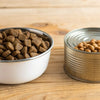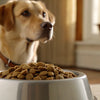Is Dry Food Better for Dogs than Wet? A Comprehensive Guide for Pet Parents
- Houndsy
Table of Contents
- Introduction
- Understanding Dry and Wet Dog Food
- Nutritional Comparisons
- Benefits of Dry Dog Food
- Drawbacks of Dry Dog Food
- Benefits of Wet Dog Food
- Drawbacks of Wet Dog Food
- Choosing the Right Food for Your Dog
- Mixing Dry and Wet Food
- Elevating the Feeding Experience with Houndsy
- Conclusion
Introduction
Did you know that nearly 70% of pet owners are unsure about the best type of food for their dogs? As dog lovers ourselves, we understand the importance of making informed choices that cater to our furry friends' health and happiness. The age-old debate of whether dry food is better for dogs than wet food can leave many of us scratching our heads. With a plethora of options available, how do we determine what’s best for our beloved pets?
In this blog post, we will explore the nuances of dry and wet dog food, delving into the nutritional benefits, convenience factors, and potential drawbacks of each. By the end, we aim to equip you with the knowledge needed to make the best dietary decision for your dog, considering their unique needs and preferences.
We’ll cover the following topics:
- An overview of dry vs. wet dog food
- Nutritional comparisons between the two types
- Benefits and drawbacks of dry food
- Benefits and drawbacks of wet food
- How to choose the right food for your dog
- Mixing wet and dry food for a balanced diet
- Our favorite feeding solutions, including the Houndsy Kibble Dispenser
Let’s embark on this journey to understand the intricacies of canine nutrition together!
Understanding Dry and Wet Dog Food
Before we dive deeper, let's clarify what we mean by dry and wet dog food.
Dry Dog Food: Often referred to as kibble, dry dog food contains low moisture content, typically between 5-10%. This food is made by mixing ingredients, cooking them, and then extruding them into various shapes and sizes.
Wet Dog Food: This food comes in cans or pouches and has a moisture content that ranges from 75-85%. It is made by cooking meat and other ingredients, then sealing them in a container to preserve freshness.
Both types serve as nutritionally balanced options, but they cater to different needs and preferences.
Nutritional Comparisons
When comparing dry and wet dog food, it's essential to look at their nutritional profiles:
Protein and Fat Content
- Dry Food: Typically contains a higher amount of carbohydrates and less fat and moisture. However, high-quality kibble is rich in proteins derived from meat sources, essential for your dog’s muscle development and overall health.
- Wet Food: Generally has a higher protein percentage due to its meat content. The fat content can also be higher, making it a richer option for dogs that require more calories.
Fiber and Carbohydrates
- Dry Food: Often contains more fiber, which aids digestion and helps maintain a healthy weight.
- Wet Food: Usually has fewer carbohydrates, which can be beneficial for dogs with specific dietary needs.
Moisture Content
- Dry Food: Contains minimal moisture, which means it’s crucial for pet owners to ensure their dogs drink enough water to stay hydrated.
- Wet Food: The high moisture content is particularly beneficial for dogs who may not drink enough water, helping to prevent urinary tract issues.
Benefits of Dry Dog Food
1. Convenience and Storage
Dry food is easier to store, lasts longer, and is less likely to spoil once opened. It can be left out for grazing without the risk of bacteria growth, making it ideal for busy pet owners.
2. Dental Health
The crunchy texture of kibble can help scrape away plaque and tartar buildup, promoting better dental health. While it shouldn’t replace regular dental care, it can be a beneficial supplement.
3. Cost-Effectiveness
In general, dry dog food is more affordable than wet food. It provides a higher nutrient density, meaning you can feed your dog less by volume.
4. Portion Control
Kibble is easier to measure and portion, allowing for more precise feeding. This is especially beneficial for dogs on weight management plans.
Drawbacks of Dry Dog Food
1. Less Palatable
Some dogs may find dry food less appealing, especially if they are used to the aroma and texture of wet food.
2. Lower Moisture
Dogs that do not drink enough water can become dehydrated, especially if they primarily consume dry food.
Benefits of Wet Dog Food
1. Palatability
Wet dog food is often more aromatic and flavorful, making it a favorite among picky eaters or dogs recovering from illness.
2. Higher Hydration
With its high moisture content, wet food can help dogs stay hydrated, which is crucial for kidney and urinary tract health.
3. Easier to Chew
For older dogs or those with dental issues, wet food is easier to chew and digest, making mealtime more enjoyable.
4. Satiety
The texture and moisture can help dogs feel full without consuming excess calories, which is beneficial for weight management.
Drawbacks of Wet Dog Food
1. Spoilage
Once opened, wet food must be refrigerated and consumed within a few days to prevent spoilage. This can lead to waste if your dog doesn’t finish their meal.
2. Cost
Wet food is generally more expensive per calorie compared to dry food. For larger breeds or multiple dogs, this can significantly increase feeding costs.
3. Dental Health
Wet food does not provide the same dental benefits as dry food and can contribute to plaque buildup.
Choosing the Right Food for Your Dog
When deciding between dry and wet food, consider factors such as your dog's age, health, lifestyle, and preferences. Here are some tips for making the best choice:
- Assess Your Dog’s Health: Consult your veterinarian, especially if your dog has special dietary needs or health conditions.
- Consider Their Age: Puppies, adults, and seniors have different nutritional needs. Choose food that fits their life stage.
- Evaluate Activity Level: Active dogs may require higher protein and fat levels, while less active dogs may benefit from lower-calorie diets.
- Watch for Allergies: Monitor your dog for any adverse reactions to specific ingredients and adjust their diet accordingly.
Mixing Dry and Wet Food
For many pet parents, a combination of dry and wet food can provide the best of both worlds. Mixing the two can enhance palatability while maintaining the benefits of both types. Here are some suggestions:
- Portion Control: When mixing, ensure you calculate the total caloric intake to prevent overfeeding. Consult your veterinarian for personalized recommendations.
- Enhancing Texture: Adding wet food to dry kibble can make meals more enjoyable for your dog, particularly for those who are finicky eaters.
- Trial and Error: Experiment with different ratios of dry to wet to find what your dog enjoys most.
Elevating the Feeding Experience with Houndsy
At Houndsy, we are passionate about enhancing the feeding experience for both dogs and their owners. Our flagship product, the Houndsy Kibble Dispenser, exemplifies our commitment to convenience and design excellence.
Key Features of the Houndsy Kibble Dispenser
- Perfect Portion Control: Our innovative crank mechanism allows you to dispense the perfect portion every time, eliminating the mess and guesswork.
- Ergonomic Design: Standing height design means no more bending over, making feeding a breeze.
- Stylish Aesthetics: The mid-century modern design complements any home décor, showing that pet care can be both functional and beautiful.
- Large Storage Capacity: With a capacity of 25-30 lbs, you can store enough food to keep your dog happy and well-fed.
- Safety Features: The auto-locking mechanism prevents accidental dispensing, keeping curious paws and little hands safe.
Discover how the Houndsy Kibble Dispenser can transform your daily feeding routine. Order yours today!
Conclusion
Choosing between dry and wet dog food ultimately depends on your dog’s individual needs, preferences, and lifestyle. Both options come with their own set of benefits and drawbacks, and the best approach is often to incorporate elements from both to create a balanced diet.
As responsible pet owners, it’s our duty to provide the best nutrition for our furry companions. By understanding the differences and benefits of each type of food, we can make informed decisions that enhance their well-being and happiness.
Now that you know the ins and outs of dog nutrition, what will your next feeding decision be? Consider trying the Houndsy Kibble Dispenser to elevate your dog’s feeding experience!
FAQ
1. Is dry food better for dogs than wet food? Both dry and wet food have their advantages. Dry food is convenient and can support dental health, while wet food is more palatable and hydrating. It ultimately depends on your dog’s individual needs.
2. Can I mix dry and wet food? Yes! Mixing dry and wet food can enhance palatability and provide a balanced diet. Make sure to adjust portions to avoid overfeeding.
3. How do I choose the right food for my dog? Consider your dog’s age, health, activity level, and preferences. Consulting with a veterinarian can help you make the best choice.
4. How often should I feed my dog? Feeding frequency depends on your dog’s age and size. Puppies may require 3-4 meals a day, while adult dogs can be fed 1-2 times a day.
5. Can wet food spoil? Yes, wet food can spoil quickly once opened. It should be refrigerated and consumed within a few days.
6. What should I do if my dog has food allergies? If you suspect food allergies, consult your veterinarian to identify the allergens and adjust your dog’s diet accordingly.
By considering these factors, we can provide our dogs with the best nutrition and care possible. Let’s keep the love and tails wagging!












